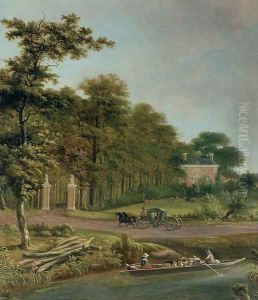J. & Velde, A.van Hackaert Paintings
Jan Hackaert, also known as J. van der Velden or simply J. Hackaert, was a Dutch Golden Age painter known for his landscapes and forest scenes. There is some uncertainty about his exact birth and death dates, but he is thought to have been born around 1628 to 1635 in Amsterdam, Netherlands. Little is known about Hackaert's early life and training, but it is believed that he was a pupil of the landscape painter Jan Baptist Weenix.
Hackaert's works often depicted the Dutch countryside, including dunes, forests, and river valleys, and he was particularly skilled at rendering trees with great detail and accuracy. He traveled within the Netherlands, but also ventured to neighboring countries like Germany, which influenced his portrayal of forested landscapes. His works were characterized by a high degree of realism and attention to the changing effects of light and atmosphere, which he captured with a subtle use of color and light.
While Hackaert did produce some works independently, he is also known for collaborating with other artists. Notably, he worked with the figure painter Adriaen van de Velde, who would often add figures to Hackaert's landscapes, a common practice among Dutch artists of the time to add value and narrative interest to their paintings. Adriaen van de Velde was born in Amsterdam in 1636 and died at the young age of 35 in 1672. He was a celebrated painter and draughtsman specializing in landscapes, animals, and figure drawing, and his collaboration with Hackaert resulted in some of the most harmonious and successful integrations of landscape and figure painting of the Dutch Golden Age.
Jan Hackaert's paintings were popular among collectors during his lifetime, and he was a member of the Guild of Saint Luke, which was the typical association for painters of the era. Despite his success, information about Hackaert's personal life remains sparse, and he is less well-known today than some of his contemporaries. His death is presumed to have occurred around 1685, but the exact year and circumstances of his death are not well-documented.
Hackaert's legacy is evident in his contribution to the development of landscape painting in the Dutch Golden Age. His works can be found in various museums and collections around the world, serving as examples of the rich tradition of Dutch landscape art.
